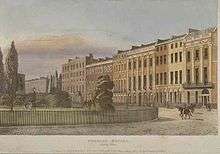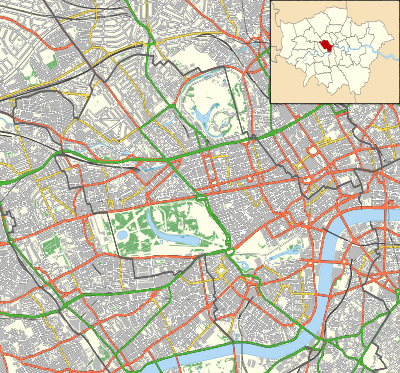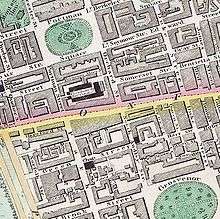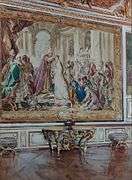Portman Square
Portman Square is a garden square in Marylebone London, specifically for private housing let on long leases having a ground rent by the Portman Estate, which owns the private communal gardens. It marks the western end of Wigmore Street, which connects it to Cavendish Square to the east.
 The square in 1813 | |
 Portman Square (City of Westminster) (local authority since 1965) | |
| Type | Garden square |
|---|---|
| Length | 530 ft (160 m) |
| Width | 400 feet (120 m) |
| Area | Marylebone |
| Location | London |
| Postal code | W1 |
| Construction | |
| Construction start | 1765 |
| Completion | 1784 |
| Other | |
| Status | west end of the north side: large building: Grade I listed |
History
Context and development
It was built between 1765 and 1784 on land belonging to Henry William Portman.
An infantry barracks, Portman Square Barracks, was built between Portman and Orchard Streets; it was demolished in about 1860.[1]
At the east end of the garden, thus marking one end of Baker Street and of Orchard Street (a short link to Oxford Street) is the Hamilton Memorial Drinking fountain. This is statutorily protected and recognised in the mainstream, initial category (Grade II).[2]
Notable residents
Its houses were in its first century let or rented in toto by Alexander Hamilton, 10th Duke of Hamilton, Sir Brook Bridges, 3rd Baronet, Henry Pelham-Clinton, 4th Duke of Newcastle-under-Lyne, George Keppel, 6th Earl of Albemarle, Sir Charles Asgill, 1st Baronet, and William Henry Percy. Alexander Duff, 1st Duke of Fife, maintained his London home at № 15.
Notable houses
About a third of the north side is in the statutory category scheme, described above but in the rarest, highest category, Grade I.[3]
- №s 11–15 built in 1773–1776 by the famous architect James Wyatt in cooperation with his brother the builder Samuel Wyatt. First houses in which Coade stone was used. Demolished in the 20th century. Ref: James Wyatt, architect to George III. Author John Martin Robinson. Yale University Press 2012.
- № 20 – Home House, built by Robert Adam between 1773 and 1777 for Elizabeth, Countess of Home, and later used by the Courtauld Institute.[3]
- № 22 – Montagu House, built in the northwest corner of the square by James Stuart between 1777 and 1781 for Mrs. Elizabeth Montagu, demolished in the Blitz by an incendiary bomb.
- № 30 – Churchill Hotel, incorporating the Michelin-starred Locanda Locatelli. This was bought on a long lease as home of George Keppel, grandson of George Keppel, 6th Earl of Albemarle (noted above), and the husband of Alice Keppel, the mistress of King Edward VII.
Gallery
 Map of much of part of Mayfair (south) and Marylebone (north) c. 1830 the square is top left
Map of much of part of Mayfair (south) and Marylebone (north) c. 1830 the square is top left- Side-view of the south side in 2008, displaying odd traffic system replaced c. 2013
 The Dining Room of № 20 in 1913
The Dining Room of № 20 in 1913
See also
References
- Walford, Edward (1878). Old and New London: Volume IV. London: Cassell, Petter & Galpin. Retrieved 4 July 2019.
- Historic England. "Hamilton Memorial Drinking fountain (1248617)". National Heritage List for England.
- Historic England. "Home House, the Courtauld Institute (occupier) (1227105)". National Heritage List for England.
External links
| Wikimedia Commons has media related to Portman Square. |